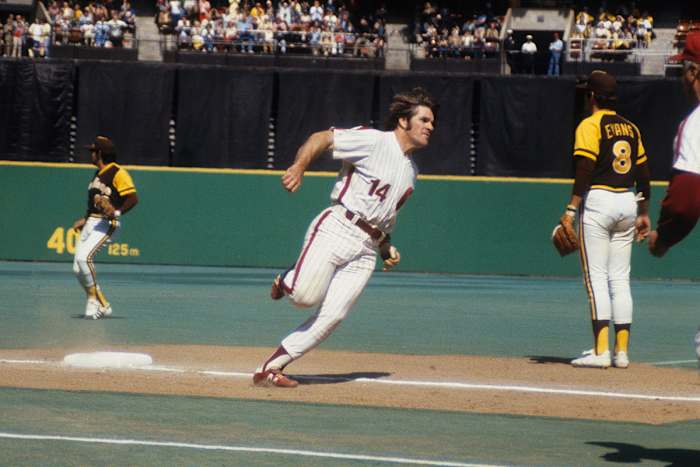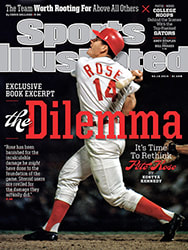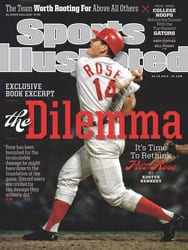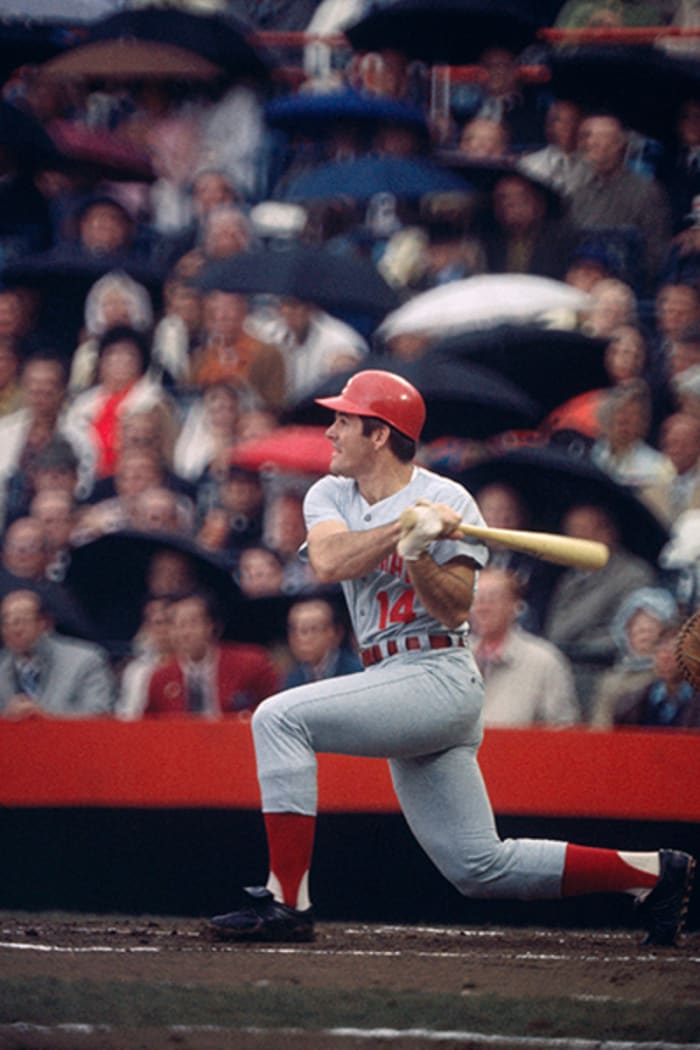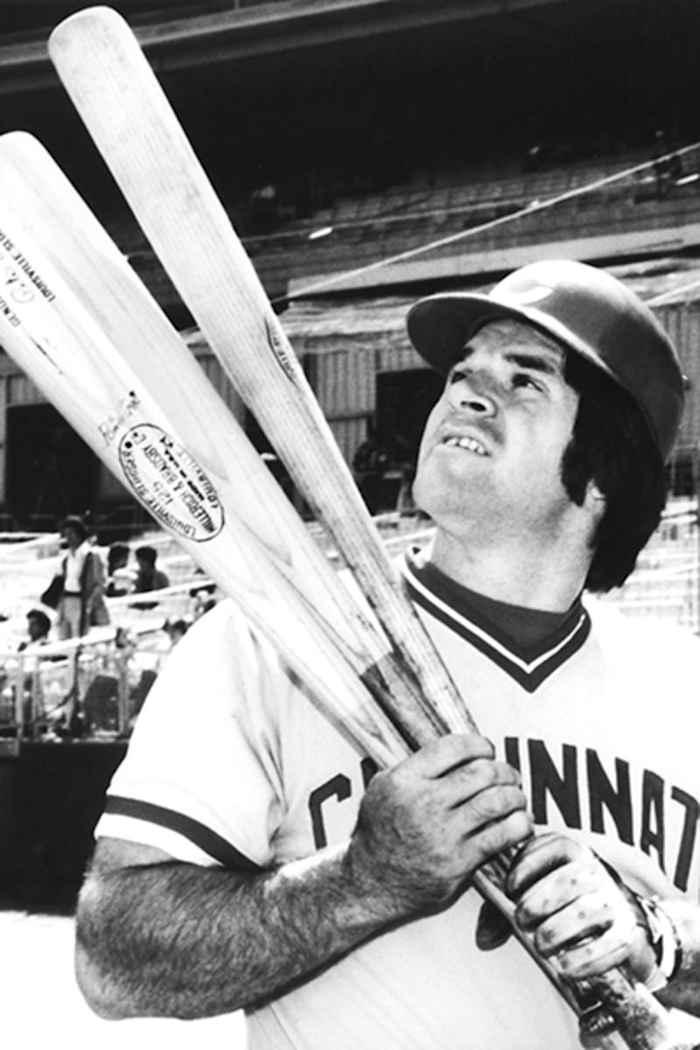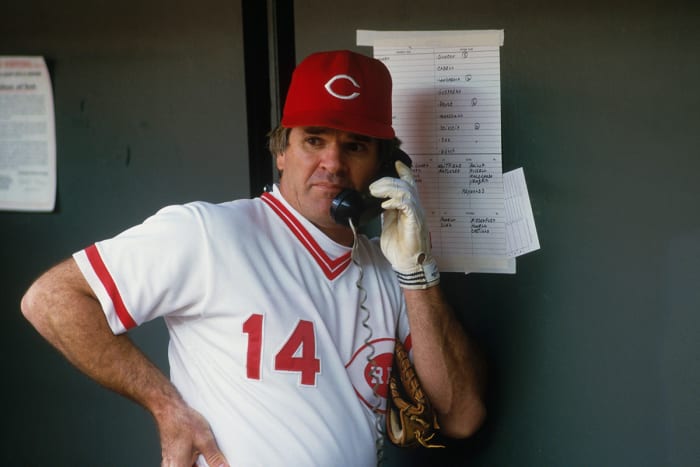The Pete Problem
While the Hall of Famers and other important baseball people tend to spend induction weekend at Cooperstown's sprawling Otesaga Resort Hotel, Pete Rose has always found his own accommodations. In 2012 he and his girlfriend Kiana Kim and her children, Ashton and Cassie, stayed in a two-bedroom apartment above the downtown Safe At Home memorabilia store where Rose signed autographs for a fee throughout the weekend. Whenever they would look out the front windows before one of Pete's signing sessions, Main Street was already thick with people crowded near the store entrance, many of them wearing Rose jerseys. "Wow!" said Cassie, 14, the first time she saw this. Trundling down the single flight of stairs a few minutes later, Rose quipped to Kiana, "Can't beat the commute, babe." The 133-room redbrick Otesaga opened more than 100 years ago, and Hall of Famers have slept there or at its sister property, the nearby Cooper Inn, during just about every induction weekend there has ever been. People gather by the enormous wooden front doors, and out back a spectacular terrace overlooks broad, immaculate green lawns and weathered oaks and glinting Otsego Lake, the Glimmerglass. There can be an air of formality in the lobby and main rooms of the Otesaga, but things are a lot looser downstairs at the Hawkeye Bar & Grill, where gaggles of Hall of Famers wind up at the end of each day. You might find stolen base king Rickey Henderson holding court at a table of 12, or come upon Phillies lefty Steve Carlton standing in the doorway of the marble-topped men's room talking about how to set up a batter for the kill. Tony Perez could walk in with one of his sons, inspiring Dave Winfield to bounce out of his armchair to say hello. Baseball front-office types and team owners mill around with drinks in hand, and over by where the rock 'n' roll house band plays, you might see a 13-time American League All-Star like George Brett start moving it like he means it on the dance floor. "If Pete came through the door," said Reds Hall of Famer Joe Morgan, standing near the bar and looking around the place, "I think everyone would stop what they were doing and go over and see him." But Rose and Kiana were half a mile away, alone with the kids in the fine apartment, which belongs to his pal Andrew Vilacky, the Safe At Home proprietor. Along with hardwood floors and a renovated master bath, the apartment is equipped with a couple of large flat-screen televisions, which Rose naturally made extensive use of. When he's not watching sports, Pete is the Fox News type. "The guy who invented TV? I love that guy!" Rose says.
Rose's presence touches that Main Street apartment even when he's not there. Two seats from the old Veterans Stadium in Philadelphia, autographed by Pete, lean against one wall, and a corner of the living room has been given over to a metallic statue of Rose sliding headfirst. Near the front door hangs a T-shirt—also signed—that reads HEY BUD TEAR DOWN THE WALL/GET PETE OFF MAIN STREET AND INTO THE HALL, as well as a baseball under glass. TO THE GREAT PETE ROSE. LOVE HIM, HATE HIM, YOU CAN'T IGNORE HIM, the ball reads, and it's signed, REGGIE JACKSON. MR. OCTOBER.
Perhaps the most interesting piece of Roseabilia in Cooperstown, however, stands not in Vilacky's apartment but a few doors down, on display at the Heroes of Baseball Wax Museum. Strange, whimsical and, yes, a little creepy, the museum features a hodgepodge of about three dozen life-sized wax figures spread among its three floors—replicas of Satchel Paige and Ted Williams, of George W. Bush throwing out a first pitch in the World Series after 9/11, of Wade Boggs on the back of a police horse after winning the World Series, of characters from the movie A League of Their Own. The wax figure of Rose bears no facial resemblance to him whatsoever, but you know who it is by the old-style Reds cap and the pin-striped vest uniform number 14. The figure stands at a podium on a stage, and behind it a simply drawn sign announces NATIONAL BASEBALL HALL OF FAME INDUCTION CEREMONY. Benches have been set up in front of this scene, and visitors to the museum can sit, gaze toward the podium and talk about what Pete might say up there if he ever did get the chance. More people do this than you might expect.
Rose's Hall of Fame worthiness has come under renewed discussion in recent years as players linked to performance-enhancing drugs have become eligible for Cooperstown, in particular two at Rose's level of accomplishment: Barry Bonds and Roger Clemens. Neither has come close to induction in their two years on the ballot, and neither have other potentially deserving players tainted by suspected steroid use. Still, all have had a fair chance; Bonds and Clemens may yet get in.
Steroids were never an option for Rose—"It's too late for me," he told a Reds trainer as PEDs began to proliferate in the mid-1980s—and he is often asked his views on players who have used those drugs. At times, even as recently as last year, Rose has referred to Alex Rodriguez as his favorite player (he has also had A-Rod programmed as a "favorite" contact in his phone), and he has suggested that players such as Bonds and Clemens are indeed Hall-worthy. But Rose has also cast sharp aspersions, saying he could only imagine what men such as Babe Ruth and Roger Maris would think to know that "guys came along and cheated their way past those records." When asked to weigh the sin of his betting on baseball against that of ingesting steroids, he has said, "To all the young kids out there, I'd say don't do either one ... but if you do the one that I didn't do, you have a good chance of hurting your body in the long run."
At the same time that baseball has over the past decade adopted an increasingly strong stance against performance-enhancing drugs, its resistance to its teams having an affiliation with gambling interests has softened. The Yankees installed the Mohegan Sun Sports Bar just above Monument Park at their new stadium. (Though of course there's no gambling in the bar, the Mohegan Sun is a prominent casino, 2½ hours northeast of Yankee Stadium.) The Tigers invite guests to their MotorCity Casino Hotel Champions Club at Comerica Park. Several other teams feature casino presences—including, yes, the Reds, who display prominent ads for Cincinnati's downtown Horseshoe Casino. When the Mets opened Citi Field in 2009, they did so with Harrah's on board as a "signature partner" and with its Caesars' Club restaurant as a core attraction. (Harrah's, remember, runs a large sports book, taking in millions of dollars in baseball bets each year.) Signage at Citi Field has advertised lasvegas.com.
The clear and enormous danger of Rose's baseball gambling lies less in its own crude execution and more in its implications. "The Pete Rose case represents the larger issue of gambling's prevalence in America," says Fay Vincent, the former baseball commissioner who, as deputy to that office, was deeply involved in Rose's 1989 banishment from the game. "It is always out there, and it is a real threat to professional sports." The crux, as ever: Gambling can lead a player to intentionally influence the outcome of a game in order to benefit a wager. A player might try to lose. And while fans will continue to pay to watch games played by athletes engorged by drugs, folks are not likely to stand for games that are not on the level.
As unsettling as it is to imagine an active major league player engaged baseball betting, a manager's involvement may be even more ominous. A corrupted manager—for example, one who might want to throw a game as a way to help erase a personal gambling debt—would have ample opportunity to make lineup and strategy decisions that work to undermine his team.
Even if a manager only wagered on his team to win, he might be swayed to give that short-term gambling interest precedence over his team's long-term needs. Theoretically, for example, in the mid-1980s as Reds manager Pete Rose bet heavily and regularly on his team, he might have called upon an already overtaxed relief pitcher to try to win a particular game rather than preserve the pitcher for the long haul of the season. While this may seem a trivial baseball subtlety to those outside the game, it's a real issue on the ground. So it should be noted that Rose had a lefthander in the bullpen, Rob Murphy, who in 1987 and '88 appeared in 163 games, the most in the National League. Murphy was effective (he had a 3.06 ERA over that time) but not remarkably so. In '88, for example, he went 0--6.
"The idea that Pete might have overused me or overused some other pitcher I was in the pen with, I never saw that at all," says Murphy. "I'd just about say it is a ridiculous idea. If anything, I wanted to pitch even more times than I got in." Murphy, who's involved in thoroughbred breeding, is still in touch with Pete. "Early May, I know I might get a call," says Murphy. "Pete will want to talk about who I like in the Kentucky Derby."
There's no indication, either through game logs or player testimony, that Rose's betting influenced how he managed. But it could have. Speculation, sure. Evidence? Not yet. Rose himself, not surprisingly, says wagering had no impact on his managing—although there's always the possibility that his stance will change. If there is enough money to be made, as even those closest to Rose will tell you, Pete can change his mind on just about anything.
Of all the ways one might characterize the differences and similarities between Rose and those players known to have used performance-enhancing drugs—the Hall of Shamers, as it were—it comes to this: Rose has been banished for the incalculable damage he might have done to the foundation of the game. Steroid users are reviled for the damage they actually did.
In 2009 a special and unexpected visitor stopped by to see Rose at his table on induction weekend: Sparky Anderson. The two had been on uneasy terms ever since Rose's banishment in 1989—Sparky, the Cincinnati manager through most of the '70s, couldn't get over how Pete had lied so brazenly about his gambling—and had not spoken in many years. As Anderson approached, frail but still vital at 75, a smile broke over his creased face, and then a mock scowl. When he got to Rose, he took off his baseball cap and, holding it by the bill, thwacked Rose back and forth about the head, muttering no-goods at him all the while. "He knocked my cap sideways!" Rose later said, laughing. It was the scolding of a boy who had strayed, a what-am-I-gonna-do-with-you! display of benevolent pique. Anderson had known Rose for nearly 40 years. "I owed him that visit. He played his heart out for me," Sparky said later to friends at the Otesaga.
People around Rose say that for the rest of that day, after Sparky had chatted for a while and then left, and the tear between them seemed suddenly, miraculously mended, Pete was in an exceptionally light mood—easier and more forgiving than usual, with all of his ebullience coming through.
About a year after that Cooperstown exchange, on an August afternoon in 2010, Rose and one of his steady associates, memorabilia dealer Charles Sotto, drove out from Los Angeles to visit Anderson at his home in Thousand Oaks. Sparky was thinner still than he had been in Cooperstown, smaller, it seemed, in every way, and his chalk-white hair was yellowing at the sides. Although the day was not at all cool, he wore a jacket inside the house. Sparky and Pete sat at a table and drank iced tea and told each other stories they both already knew—about the Big Red Machine, Anderson's own playing career and Pete's hit record, and about so many people they had known in the game that had once been everything to both of them. Sparky had some trouble hearing Rose, had trouble at times deciphering the rapid, Roseian chatter-scat that had once been part of the sound track of his life. That was O.K., though, because Pete did not mind repeating himself for Sparky.
They phoned former Reds coach George Scherger and left messages on his voice mail—Sparky and Pete calling. Together!—and they took a few snapshots standing side by side in the kitchen. And when, five or perhaps six hours after pulling in, Pete and Sotto finally got up to go so that Sparky and his wife, Carol, could eat their supper and Rose could get back to L.A., Sparky came to the front door and stood there watching them go.
Six weeks after that visit to Thousand Oaks—and six weeks before the November morning when Sparky would quietly pass away—Rose officially returned to the ballpark in Cincinnati. The Reds had invited him to commemorate, before a Saturday-night game on Sept. 11, 2010, the 25th anniversary of his 4,192nd hit. On the big screen, video aired of the Ty-breaking at bat and the pandemonium surrounding it, and then a recorded message played through the stadium: Pete's voice recalling that night and hailing his teammates and thanking the fans who "made everything possible ... made everything what it was." The sky was clear, and the evening sun still shone.
Rose was driven out in a cart from the bullpen, traveling in foul territory along the rightfield line until he signaled to the driver, "Here, this is fine." The cart stopped, and Pete lumbered out and began to walk toward first base as the crowd rustled and cheered, the hooting increasing when Pete neared the bag and, once there, raised his right leg and stomped his foot hard upon it. Home again. Cries of "Peeete! Peeete!" came out of the stands and then a spontaneous chant: "Hall of Fame! Hall of Fame! Hall of Fame!"
The whole scene, this particular Cincinnati homecoming, almost never happened. The Reds organized it, and commissioner Bud Selig gave the O.K., but at first Pete said he couldn't make it to the ballpark that night on account of his having committed to do a paid dinner appearance in a ballroom at the Hollywood Casino over in Lawrenceburg, Ind. The casino operators said that was absurd, that of course Pete should go and appear at the Great American Ball Park, and that he could just come over to the casino afterward. They would push the start time back; the customers could wait.
And would he still collect his check, the full amount? Pete wanted to know, making sure to get a guaranteed yes.
The purpose of the casino dinner was a roast of Rose, and teammates came up one by one to give him a zing: Tom Browning, George Foster, Tony Perez, Ken Griffey Sr.... About 500 people were in the room, seated at round tables of 10 or 12. Rose's son Petey took the microphone briefly and made a crack about his dad's retro-chic clothes. At one point the lights dimmed and a clip aired of Rose singing in an old Aqua Velva commercial.
Then Pete himself got up there. By now the night was nearing its end, and the coffee cups were half-full on the tables and the wine had been drunk. Everyone's attention was right up front on Pete, this being the moment they had all really come for. Rose zapped Perez (for his unusual use of English) and Griffey (for his batting style), and Rose told the one about the time Petey had phoned him from the minor leagues, battling through an 0-for-22 stretch, to ask his father the best way to get out of a slump. And Rose answered, "How the hell would I know? I've never been in a slump. Call [Dave] Concepcion."
Not only was Pete Jr. there, but Tyler Rose as well. Maybe what happened next was because those two were in the room (it was so rare to have his sons together), and maybe it was also because of the aftereffects of the celebration at the ballpark that night and having so recently seen Sparky in the condition he was in, and also having those teammates in the room around him, but what happened next, to everyone's great surprise, is that Pete broke down. His voice did not simply waver or crack, he began to sob, much as he had while standing on first base 25 years ago that night.
"I was covering this dinner, and it was kind of standard stuff," says John Erardi, a reporter for The Cincinnati Enquirer, "but then Rose started to lose it, and that really got your attention. It felt completely unscripted, completely sincere and very powerful. I had covered Rose for more than 25 years and hadn't ever heard him like that."
Rose told the room that he finally understood what it meant to "reconfigure" his life. He said, "I disrespected baseball." He looked at Perez—calling him, "like a brother to me"—and apologized directly, and also apologized to the other teammates from the Big Red Machine. "I'm a hardheaded guy," Rose choked out. "But I'm a lot better guy standing here tonight.... I guarantee everyone in this room I will never disrespect you again." As he fought to get his composure, he added, "I love the fans, I love the game of baseball, and I love Cincinnati baseball."
Before that night, even in the years after he'd made his admissions in his 2004 book, My Prison Without Bars, Rose had talked about his gambling with a kind of swagger, that familiar screw-you defiance. "It was like, Yeah, I bet on my team every night to win! So what? I'm a winner!" says Greg Rhodes, a Reds team historian. But this was completely different. Something had come over Pete. As Browning puts it, "We saw a man humbled that night. Pete was definitely humbled, and he was ashamed. You could see inside him, and with the way Pete usually is, that was not something any of us expected."
Browning and Erardi, Perez and Rhodes, and other people around the Reds had similar thoughts in the days after that night, a few questions they would discuss among themselves. They wondered, Was this the kind of apology everyone had been waiting for? When word got back to baseball's leadership about how contrite Pete had been up there, would it matter? Would Bud Selig think anything of it at all?
Ever since taking on the commissioner's role, replacing Fay Vincent more than 20 years ago, Selig has been caught in the middle when it comes to Rose, straddling a line. The commissioner has been asked about his position on Rose, publicly and privately, many hundreds of times, and he has never suggested that he would bend on Rose's permanent ban. But he has listened to Rose and his advocates, and also, in recent years, to an informal lobbying campaign from the Reds. ("There's a hope on our part that maybe when Selig leaves office [after the 2014 season], he might pardon Rose on his way out," one member of the team's brass told me.) Selig let Rose participate in events such as the 4,192 celebration at the Great American Ball Park, because he knows that a chance to embrace Pete Rose is something that some fans want.
"Selig has been pretty good when it comes to Rose," says Vincent, "but he has also shown a lack of conviction.... When he lets Rose onto the field, when he does not enforce the rules, then what do the rules mean?"
Selig went to Cooperstown for the 2012 Hall of Fame inductions, as usual, and on Sunday morning he was standing near the entrance of the Otesaga, about to get into a car to go to the induction ceremony, when Larry Christenson, Rose's former Phillies teammate, spotted him. "I went over and asked, 'Would you listen if Pete were to come and talk with you again? Would you be open to talking about him getting back into baseball?' " says Christenson. "I tried to make a quick case for it." But Christenson says Selig did not give an answer. He smiled, shook his head and politely put up a hand before getting into the car.
A couple of hours later Selig stood on the broad, outdoor stage at the induction ceremony, reading, as is the commissioner's charge, Barry Larkin's newly created plaque. "Smooth-fielding, steady-swinging shortstop whose dynamic defense and all-around play sparked his hometown Reds," read Selig. There were 44 Hall of Fame players seated behind him and more than 18,000 fans sprawled out on the great lawn before him, on folding chairs, blankets, coolers. It was a bright and very hot day, and though the stage was well-shaded in an elaborate clamshell, out on the lawn people slathered on sunblock and fanned themselves with paper fans and occasionally poured bottled water over their brows.
"A 12-time All-Star, he totaled 2,340 hits and 379 stolen bases in 19 seasons," Selig continued. He read Larkin's plaque inscription right through to the last line: "He batted .353 in the 1990 World Series, guiding Reds to four-game sweep of Oakland A's."
Amid applause and cheers, Larkin came to the dais in his suit, officially the 45th Hall of Fame inductee on the stage. He thanked Hall president Jeff Idelson. He thanked his wife, Lisa, and his parents, Robert and Shirley. He thanked his daughters and his siblings, and then he started to talk about growing up in Cincinnati, about going to Moeller High and rooting for the Reds in the 1970s, and going on to play baseball at the University of Michigan.
Larkin gave thanks all over the place—classy—and called out many people specifically. The crowd cheered and clapped at the names they recognized. Sparky Anderson. Bo Schembechler. Rod Carew. After the dozens of passing mentions Larkin began his first extended anecdote of the afternoon. He said, "I played with some monumental figures in the game of baseball, and I want to acknowledge a few of those guys." Larkin paused, and you could hear a few rowdy yelps come out of the crowd as someone shouted the name.
"You know it," Larkin said. "Pete Rose. 4,256 of them. That's right." The fans really roared then, all those people who had made the trip from Cincinnati and had been out for hours in their replica Reds jerseys on their folding chairs beneath the sun.
Larkin spoke about how Pete helped him through some "very rough times as a young player," and then he told this story from his first major league game, when Pete was managing the Reds and Larkin had arrived late and was without any of his equipment. "Pete's walking out of his office, and he looks at me and says, 'Larkin, it's your first day in the big leagues and you're already late.' And I go, 'Skip, I don't have anything.'
"So he laughs, we share a few minutes, he asks me, he says, 'You got any bats, gloves, anything?'
"I'm like, 'No, I have nothing.'
"He's like, 'Well, what size bat do you use?'
"I go, 'Whatever size you use, Skip.'
" 'How about your shoes, what size shoe you wear?'
" 'Those Mizunos, they look like they'll work.'
"He says, 'All right, here you go.' So I take it.
"It gets no better than the first day of the big leagues, playing for the hometown team. Pete Rose, my manager, I've got his bat, I've got his shoes."
After the game, Larkin went on, after he'd pinch-hit and driven in a run and finished speaking with the media in the clubhouse, "Pete walks over to me and says, 'How was that?' I said, 'That was awesome, man.' He talks to me about growing up in Cincinnati, he talks to me about the opportunity to represent the hometown, the responsibilities of being a Red, how to conduct myself in a professional manner. He spends, like I said, about half an hour with me and finally asks me, 'It feel good in your hand, that bat? Those shoes, they feel good on your feet?' I was like, 'They are awesome.' He's like, 'Good. Give them back.' I said, 'What?' He said, 'Your stuff will be here tomorrow. Give me my stuff back.' "
Some of the players on the stage cracked up—Yep, that's Pete—and the crowd on the lawn laughed too. Larkin said how he had been planning to take that bat and those shoes home with him and keep them forever, but Pete was a step ahead of him. "I just want to thank Pete for the opportunity," said Larkin, speaking now in more general terms. "His words of wisdom and his support and him talking to me all the time. Thank you, Pete Rose. I love you, man."
It was right about then, not yet three o'clock on a Sunday afternoon, July 22, 2012, with the Hall of Famers listening to Larkin's speech and some chuckling at the stories and some applauding and others not, and Selig sitting with that neutral look on his face, listening, and the crowd out there on the hot, clear day in Cooperstown, whooping for Pete and calling his name, 1.1 miles from the plaque gallery at the Hall of Fame, it was right about then that you could get a sense, a realization, that maybe this right here was as close to a Baseball Hall of Fame induction ceremony as Pete Rose will ever get.
After baseball's steroid stain, Rose's Hall worthiness is under renewed discussion.
Anderson grew apart from Rose, but said, "He played his heart out for me."
"I just want to thank Pete," Larkin said. "His words of wisdom and his support."
